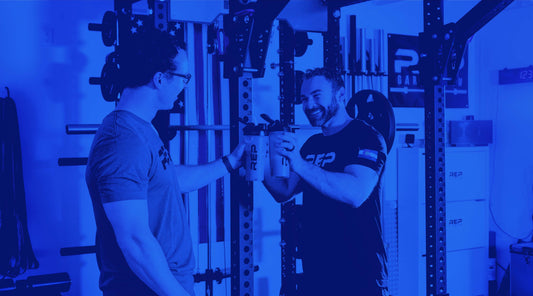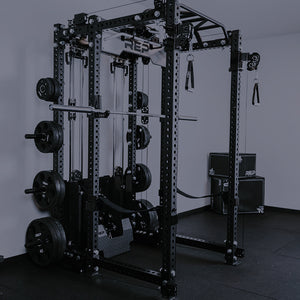
Buckle up, buttercup.
If you aren’t using a lifting belt, you’re leaving gains on the table — period.
Weightlifting belts aren’t just for competitive powerlifters or those afflicted by back injuries. When utilized appropriately, a lifting belt can enhance your athletic potential and encourage good form, both of which result in more gains over time.
And, no, lifting belts aren’t “cheating,” whatever that means. Buckle up; we’re breaking down the do’s and don’t’s of lifting belts and showing you the science behind why they work.
What Does a Lifting Belt Do?
Before we get into how a lifting belt can improve your workouts (and the results you get), let’s first dispel some myths and misconceptions.
Here’s what lifting belts do not do:
- Prevent or significantly reduce injury risk at all times.
- Lift the weight for you or help you “cheat” the exercise.
- Reduce muscle activation in your core.
Weightlifting belts — like squat shoes, wrist wraps, chalk, or lifting straps — are a tool meant to augment your performance in the weight room. No more, no less.

Benefits of Lifting Belts
The primary purpose (and benefit) of a lifting belt is to provide an external surface to brace against, increasing intra-abdominal pressure (IAP) and, by extension, boosting the force you can produce when lifting weights.
Think of it like this: You can flex your triceps much harder by pressing your palm against the wall and pushing than holding your arm out and squeezing. Weightlifting belts do the same thing for your core.
But that’s not all that’s going on when you bind a belt around your waist. Studies have shown that…
- Lifting belts increase muscle activation in your abdominals and obliques. (1)
- Using a belt increases force output, helping you move heavy weights faster. (2)
Do Lifting Belts Reduce Back Injury Risk?
Here’s the deal: There is very limited research directly examining whether weightlifting belts inherently reduce injury risk to the spine.
Some literature acknowledges the propensity of belting up to reduce spinal injury, (3) but not because the belt itself does anything special — rather, wearing a belt tends to encourage better form and more intense bracing, which likely explains why these belts are seen as back support for lifting and injury prevention tools.
The short answer: Not directly, but belts encourage you to use good form and brace your core, which can help reduce the risk of injury.
When Should I Use a Lifting Belt?
The short answer: On lower-body compound (that’s multi-joint) exercises when working with moderate to heavy loads, and especially if you’re maxing out.
You can technically wear a belt for your entire workout, but that doesn’t mean it’s helping the entire time (more on that below). Here’s a top-level prescription you can stick to:
- On leg day: For heavy, free-weight squats and deadlifts (or their variations), as well as exercises which demand lots of coordination like lunges or overhead squats.
- During upper-body workouts: Try a belt on exercises which affect your spine/core, even if those areas aren’t the target musculature — think barbell rows or standing overhead presses.
For Strength Athletes
- In addition to the squat and deadlift, powerlifters will sometimes wear a belt during the bench press to help with general stability.
- You’ll also see Olympic lifters use thin leather or Nylon belts which don’t inhibit mobility.
- Strongmen frequently opt for larger, thicker belts while performing tosses, pulls, or carries.
When To Avoid Lifting Belts
The literature backing belts is strong and comprehensive, but that doesn’t mean they’re a must-have for every gymgoer. If you fall into any of these camps, you may want to steer clear of a belt:
- If you have certain medical conditions. Belts increase blood pressure, which could be detrimental if you take medication, or have hemorrhoids or a hernia.
- If the belt noticeably interferes with your technique.
- If the belt impedes your mobility or posture when lifting.
- If you come to rely on the belt as a mental crutch and experience significant apprehension or anxiety when you can’t wear one.
- If you compete in a strength sport which prohibits or regulates belt usage.
Scientific studies have also outlined certain situations in which it is “inappropriate” or unproductive to use a belt; for very light loads like early warm-ups, or on exercises which do not stress the musculature of the trunk or lumbar spine. (4)
However, that doesn’t mean belting up is detrimental, especially if doing so brings you mental comfort. Just don’t expect much from using a belt during bicep curls.

What Type of Lifting Belt Is Right for Me?
All belts are not created equal. Similar to a golfer selecting the right club for the shot they need to take, gymgoers and strength athletes need a belt built for the type of training they’re doing.
Types of Lifting Belts
- Material: Heavy-duty lifting belts for strength sports are made of several layers of fused leather. Lighter, less supportive belts are typically made of Velcro.
- Size: Belts vary in width. A leather weight lifting belt is typically around 8 to 13mm thick — thicker belts are more durable, but can be uncomfortable to wear.
- Fastening: Leather belts come with a buckle and notches, or a lever mechanism. The former is more ergonomic and convenient to use, but the latter is more secure. Velcro belts tend to lose their stickiness over time.
- Dip: You can also buy a dip belt, which is made with chains through which you loop weight plates for dips (duh), pull-ups, and other loaded calisthenics.
Lever vs. buckle and prong: A lever fastener is the most secure locking mechanism for a leather belt, period. However, you can’t adjust the tightness of the belt on the fly—you’ll typically need a small screwdriver.
If you’re changing your body composition, wait until you reach your desired body size before committing to a lever belt.
Your Cheet Sheet
The short answer: The heavier or more vigorous your lifting is, the sturdier your belt should be.
- For general strength training: Grab a Velcro belt or a thin leather belt with a buckle.
- For powerlifting: Opt for a secure leather belt with the fastening style of your choice.
- For Olympic lifters: For maximal freedom of movement, get a Velcro belt — many weightlifters will opt for a thin leather belt on the clean & jerk and for squats, and often prefer belts that are wider in the back than in the front to reduce the chance of the barbell making contact with the belt.
One big thing: If you’ve never used a belt before, don’t expect to slap one on and immediately hit a new personal record. There’s a learning curve to lifting belts.
- One study showed no difference in force output when novices who never used a belt before added one and performed a maximal isometric strength test. (5)

How To Wear A Lifting Belt: The Right Size, The Perfect Fit
A lifting belt wraps snuggly around your midsection above your hip bones. The fit should also maintain continuous contact with your abdominals and lower back, but shouldn't be so tight it makes breathing feel like a chore.
Remember Goldilocks & the three bears? Getting your belt size is about finding a fit that’s just right. If you use a Velcro belt, this isn’t as much of a concern—but for a leather belt, the right fit matters.
First of all: Read up on the sizing recommendations or follow the size chart if one exists. But beyond that…
- Leather belts should be very snug and slightly uncomfortable when fastened, but not so tight that you can’t breathe.
- You should be able to fit your pinky finger between the belt and your stomach.
One big thing: When it comes to heavy-duty belts, there’s such a thing as too tight. You must be able to expand your stomach as you inhale and brace, so you need a bit of extra room.
A belt is not a corset.
TL;DR: Belts Are Better
Serious lifters of all stripes rely on lifting belts no matter their strength sport of choice, or their level of experience. A good belt belongs in every lifter’s gym bag.
- Lifting belts help you produce more power and engage your core.
- Belts are not “cheating”, but some sports do regulate what kind of belt you can use.
- Research on safety and injury risk is mixed; most people feel more stable and secure with a belt on, though.
FAQs
Do lifting belts prevent injury?
Not directly, but lifting with belt support can help you brace your core and maintain good form when tackling heavy weights, which will reduce your risk of injury.
What exercises should I use a lifting belt on?
Belts are beneficial for compound, multi-joint free weight training—think squats, deadlifts, rows, or lunges. You’re free to use a belt on whichever exercises you want, but don’t expect them to do much for your arm or calf workouts.
What size lifting belt should I get?
To find the perfect fit, follow size chart guidelines if they're available. When trying one on, you want the belt tight but not too tight. You should still be able to fit your pinky finger between the belt and your stomach.
Do weight lifting belts help lower back pain?
A weight lifting belt can help you maintain good form through your lifts, which can be of serious use for people who struggle with lower back pain after their workouts. Additionally, the belt encourages you to brace your core. However, if you have lower back pain, it's best to consult with a medical expert to identify underlying issues.
References
- Escamilla RF, Francisco AC, Kayes AV, Speer KP, Moorman CT 3rd. An electromyographic analysis of sumo and conventional style deadlifts. Med Sci Sports Exerc. 2002 Apr;34(4):682-8. doi: 10.1097/00005768-200204000-00019. PMID: 11932579.
- Zink AJ, Whiting WC, Vincent WJ, McLaine AJ. The effects of a weight belt on trunk and leg muscle activity and joint kinematics during the squat exercise. J Strength Cond Res. 2001 May;15(2):235-40. PMID: 11710410.
- Fong SSM, Chung LMY, Gao Y, Lee JCW, Chang TC, Ma AWW. The influence of weightlifting belts and wrist straps on deadlift kinematics, time to complete a deadlift and rating of perceived exertion in male recreational weightlifters: An observational study. Medicine (Baltimore). 2022 Feb 18;101(7):e28918. doi: 10.1097/MD.0000000000028918. PMID: 35363215; PMCID: PMC9282110.
- Finnie SB, Wheeldon TJ, Hensrud DD, Dahm DL, Smith J. Weight lifting belt use patterns among a population of health club members. J Strength Cond Res. 2003 Aug;17(3):498-502. doi: 10.1519/1533-4287(2003)017<0498:wlbupa>2.0.co;2. PMID: 12930176.
- Miyamoto K, Iinuma N, Maeda M, Wada E, Shimizu K. Effects of abdominal belts on intra-abdominal pressure, intra-muscular pressure in the erector spinae muscles and myoelectrical activities of trunk muscles. Clin Biomech (Bristol). 1999 Feb;14(2):79-87. doi: 10.1016/s0268-0033(98)00070-9. PMID: 10619094.
Jake Dickson holds a B.S. degree in Exercise Science and is a NASM-CPT. As a health & wellness writer, Jake focuses on making fitness practical and accessible for any audience. Off the clock, you can find Jake at the gym or unwinding by the beach.
This article was reviewed by Rosie Borchert, NASM-CPT, for accuracy.

NEWSLETTER SIGNUP
Product launch information, promotions, blogs, and REP news.







